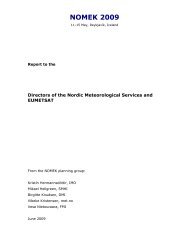International Symposium on Mitigative Measures against Snow ...
International Symposium on Mitigative Measures against Snow ...
International Symposium on Mitigative Measures against Snow ...
Create successful ePaper yourself
Turn your PDF publications into a flip-book with our unique Google optimized e-Paper software.
<str<strong>on</strong>g>Internati<strong>on</strong>al</str<strong>on</strong>g> <str<strong>on</strong>g>Symposium</str<strong>on</strong>g> <strong>on</strong> <strong>Mitigative</strong> <strong>Measures</strong> <strong>against</strong> <strong>Snow</strong> Avalanches<br />
Egilsstaðir, Iceland, March 11–14, 2008<br />
around the structures was similar to that predicted by Tabler (1991) and snow was not being<br />
eroded from the lee side of the fences due to high wind speeds. The design of the fences used<br />
in the test were however not optimal according to Tabler (2003) and Swiss experience<br />
(Margreth, 1997) and can therefore not be used to c<strong>on</strong>clude <strong>on</strong> optimal design of the<br />
structures under Icelandic weather c<strong>on</strong>diti<strong>on</strong>s.<br />
Figure 2: <strong>Snow</strong> fences to the left and wind baffles to the right in use in Switzerland (photos:<br />
Stefan Margreth).<br />
Nothing has been written about the design of wind baffles for Icelandic c<strong>on</strong>diti<strong>on</strong>s. Such<br />
structures c<strong>on</strong>sist of <strong>on</strong>e or two cross-shaped boards with <strong>on</strong>e or two posts and are widely<br />
used elsewhere to break up large c<strong>on</strong>tinuous cornices or to separate avalanche starting z<strong>on</strong>es<br />
(see Figure 2). A wind baffle forms a disc<strong>on</strong>tinuity in the snow distributi<strong>on</strong> by increased snow<br />
erosi<strong>on</strong> around the structure. The snow erosi<strong>on</strong> is caused by an increase in the wind speed in<br />
the vicinity of the baffle and the effectiveness of the baffle is not affected by the exact wind<br />
directi<strong>on</strong>. If several wind baffles are built side by side the formati<strong>on</strong> of a large c<strong>on</strong>tinues<br />
cornice can be prevented.<br />
One of the biggest challenges in the use of snow drift measures in Iceland is designing<br />
durable structures, especially when integrating such structures into avalanche protecti<strong>on</strong> plans<br />
for inhabited areas. The uncomm<strong>on</strong>ly high wind speed and sudden changes in wind directi<strong>on</strong><br />
<strong>on</strong> mountaintops in Iceland might also affect the optimal design of the structures and pose<br />
problems regarding snow erosi<strong>on</strong> <strong>on</strong> the lee side of the structures. Complicated wind patterns<br />
<strong>on</strong> mountaintops could be modeled with high resoluti<strong>on</strong> computer simulati<strong>on</strong>s in order to<br />
evaluate the possibilities of installing useful snow fences, such as was d<strong>on</strong>e in the<br />
Hafnarhyrna starting z<strong>on</strong>e in Siglufjörður in northern Iceland (Þórðars<strong>on</strong> and Jónss<strong>on</strong>, 2005).<br />
3. SNOW DRIFT MEASURES ABOVE PATREKSFJÖRÐUR<br />
The town of Patreksfjörður is located <strong>on</strong> the Westfjords peninsula. The town sits under the<br />
mountain Brellur which rises up to 400−500 m a.s.l. The avalanche pr<strong>on</strong>e area Urðir is<br />
located above the harbour (see Figure 3). The main starting z<strong>on</strong>e for the avalanches is a<br />
relatively shallow but wide depressi<strong>on</strong> at 200−340 m a.s.l. Above the bowl there are 10−20 m<br />
high steep cliff bands. The mountaintop is flat and extensive.<br />
Hák<strong>on</strong>ardóttir, Margreth, Tómass<strong>on</strong>, Indriðas<strong>on</strong> and Þórðars<strong>on</strong> 87











